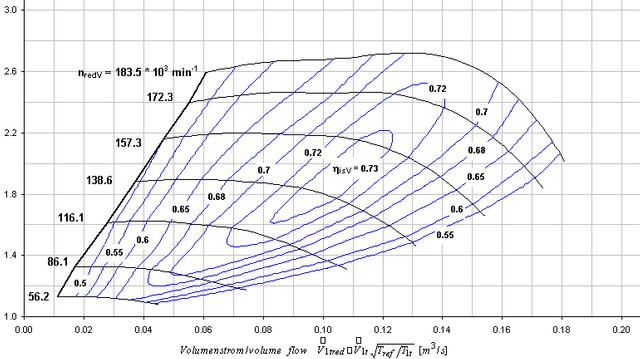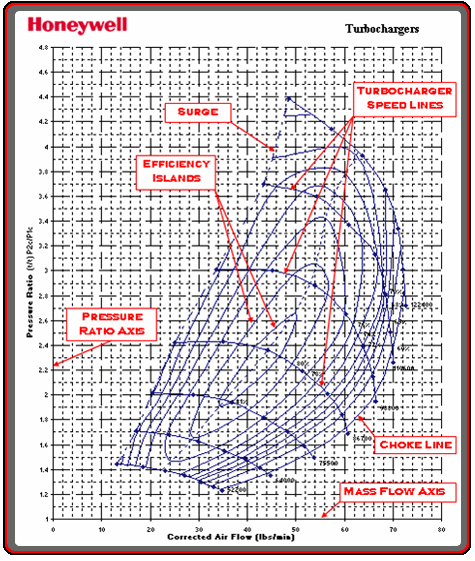Compressor map: Difference between revisions
(→g/sec) |
|||
| (28 intermediate revisions by 2 users not shown) | |||
| Line 1: | Line 1: | ||
[[Image:Example_compressor_map.gif|right]] |
[[Image:Example_compressor_map.gif|right]] |
||
;Pressure ratio (y-axis): The absolute |
;Pressure ratio (y-axis): The absolute outlet pressure divided by the absolute inlet pressure. |
||
;[[Mass air flow]] rate (x-axis): The mass of air flowing through the intake/compressor over time. Usually lbs/min or CFM. |
;[[Mass air flow]] rate (x-axis): The mass of air flowing through the intake/compressor over time. Usually lbs/min or CFM. |
||
| Line 18: | Line 18: | ||
==Pressure Ratio== |
==Pressure Ratio== |
||
Expressed as <math>\frac{P_{outlet}}{P_{inlet}}</math> or, more commonly, <math>\frac{P_{ |
Expressed as <math>\frac{P_{outlet}}{P_{inlet}}</math> or, more commonly, <math>\frac{P_{ambient} + P_{boost} + P_{ICdrop}}{P_{ambient} - P_{id}}</math> |
||
Where |
Where |
||
*<math>P_{outlet}</math> is the absolute pressure at the turbo compressor outlet |
*<math>P_{outlet}</math> is the absolute pressure at the turbo compressor outlet |
||
*<math>P_{inlet}</math> is the absolute pressure at the turbo compressor inlet |
*<math>P_{inlet}</math> is the absolute pressure at the turbo compressor inlet |
||
*<math>P_{ |
*<math>P_{boost}</math> is pressure at the throttle body inlet |
||
*<math>P_{ambient}</math> is ambient air pressure |
*<math>P_{ambient}</math> is ambient air pressure |
||
*<math>P_{ICdrop}</math> is intercooler pressure drop (pressure difference between <math>P_{outlet}</math> and <math>P_{ |
*<math>P_{ICdrop}</math> is intercooler pressure drop (pressure difference between <math>P_{outlet}</math> and <math>P_{ambient} + P_{boost}</math>) |
||
*<math>P_{id}</math> is intake pressure drop (pressure difference between <math>P_{inlet}</math> and <math>P_{ambient}</math>) |
*<math>P_{id}</math> is intake pressure drop (pressure difference between <math>P_{inlet}</math> and <math>P_{ambient}</math>) |
||
Alternately, if boost is known, it is approximated by <math>\frac{P_{ambient} + P_{boost}}{P_{ambient} - P_{id}}</math>. Intercooler drop is ignored here for simplicity. |
|||
===Examples=== |
===Examples=== |
||
[http://www.google.com/intl/en/help/features.html#calculator Google calculator] provides a handy way to deal with unit issues. |
[http://www.google.com/intl/en/help/features.html#calculator Google calculator] provides a handy way to deal with unit issues. |
||
For example, with |
For example, with 19psi boost, 1psi IC drop, and 1psi inlet drop, type this into google (assuming you live at sea level): |
||
<code>(1 atm + |
<code>(1 atm + 19 psi + 1 psi)/(1 atm - 1 psi)=</code> |
||
and you get: |
and you get: |
||
[http://www.google.com/search?q=%281+atm+%2B+20+psi%29%2F%281+atm+-+1+psi%29%3D <code>(1 atm + |
[http://www.google.com/search?q=%281+atm+%2B+20+psi%29%2F%281+atm+-+1+psi%29%3D <code>(1 atm + 19 psi + 1 psi) / (1 atm - 1 psi) = 2.53</code> ] |
||
A few others: |
A few others: |
||
*[http://www.google.com/search?q=%281+atm+%2B+1+bar%29%2F%281+atm+-+1+psi%29%3D <code>(1 atm + 1 bar) / (1 atm - 1 psi) = 2. |
*[http://www.google.com/search?q=%281+atm+%2B+1+bar%29%2F%281+atm+-+1+psi%29%3D <code>(1 atm + 1 bar) / (1 atm - 1 psi) = 2.13</code> ] |
||
*[http://www.google.com/search?q=%281+atm+%2B+1.3+bar%29%2F%281+atm+-+1+psi%29%3D <code>(1 atm + 1.3 bar) / (1 atm - 1 psi) = 2. |
*[http://www.google.com/search?q=%281+atm+%2B+1.3+bar%29%2F%281+atm+-+1+psi%29%3D <code>(1 atm + 1.3 bar) / (1 atm - 1 psi) = 2.45</code> ] |
||
*[http://www.google.com/search?q=%281+atm+%2B+22+psi%29%2F%281+atm+-+1+psi%29%3D <code>(1 atm + |
*[http://www.google.com/search?q=%281+atm+%2B+22+psi%29%2F%281+atm+-+1+psi%29%3D <code>(1 atm + 21 psi + 1 psi) / (1 atm - 1 psi) = 2.68</code> ] |
||
*[http://www.google.com/search?q=%281+atm+%2B+24+psi%29%2F%281+atm+-+1+psi%29%3D <code>(1 atm + |
*[http://www.google.com/search?q=%281+atm+%2B+24+psi%29%2F%281+atm+-+1+psi%29%3D <code>(1 atm + 23 psi + 1 psi) / (1 atm - 1 psi) = 2.83</code> ] |
||
As you can see, as ambient pressure drops (e.g. higher elevation) or intake/IC drops increase, your pressure ratio increases along with it. |
|||
==Boost from Pressure Ratio== |
|||
To calculate boost from desired pressure ratio: |
|||
<math>P_{boost} = PR (P_{ambient} - P_{ICdrop}) - P_{ambient} - P_{id}</math> |
|||
For example, with 2.5 PR, 1psi IC drop, and 1psi inlet drop, type this into google (assuming you live at sea level): |
|||
<code>2.5 * (1 bar - 1 psi) - 1 bar - 1 psi in psi</code> |
|||
and you get: |
|||
[https://www.google.com/#q=2.5+*+(1+bar+-+1+psi)+-+1+bar+-+1+psi+in+psi <code>2.5 * (1 bar - 1 psi) - 1 bar - 1 psi in psi</code> = 18.3 pounds per square inch ] |
|||
As you can see, as ambient pressure drops (e.g. higher elevation) or intake/IC drops increase, your boost limit (for a given PR limit) decreases along with it. |
|||
==Air Flow== |
==Air Flow== |
||
| Line 59: | Line 75: | ||
To convert grams per second into pounds per minute, divide by 7.55 |
To convert grams per second into pounds per minute, divide by 7.55 |
||
[http://www.google.com/search?q=300+grams+per+second+in+pounds+per+minute 300 (grams per second) = 39. |
[http://www.google.com/search?q=300+grams+per+second+in+pounds+per+minute 300 (grams per second) = 39.68 pounds per minute] |
||
To convert grams per second into m<sup>3</sup>/sec, divide by 1225 (density of air at sea level) |
To convert grams per second into m<sup>3</sup>/sec, divide by 1225 (density of air at sea level) |
||
300 / 1225 = 0. |
300 / 1225 = 0.2449 |
||
| ⚫ | |||
| ⚫ | |||
'''If you have two turbos, divide g/sec by twice that, or 2450''' |
'''If you have two turbos, divide g/sec by twice that, or 2450''' |
||
300 / 2450 = 0. |
300 / 2450 = 0.1224 |
||
[http://www.google.com/search?q=%28300%2F2+grams+per+second%29%2F%281225+g+per+cubic+meter%29%3D (300/2 (grams per second)) / ((1 225 g) per (cubic meter)) = 0. |
[http://www.google.com/search?q=%28300%2F2+grams+per+second%29%2F%281225+g+per+cubic+meter%29%3D (300/2 (grams per second)) / ((1 225 g) per (cubic meter)) = 0.1224 m<sup>3</sup> / s] |
||
====From horsepower==== |
====From horsepower==== |
||
| Line 78: | Line 93: | ||
To convert horsepower to m<sup>3</sup>/sec, divide by 1620 |
To convert horsepower to m<sup>3</sup>/sec, divide by 1620 |
||
420 / 1620 = 0. |
420 / 1620 = 0.259 |
||
[http://www.google.com/search?q=%28420+horsepower%29%2F%2810+horsepower+per+%28lb+per+minute%29%29%2F%281225+g+per+cubic+meter%29%3D ((420 horsepower) / ((10 horsepower) per (pound per minute))) / ((1 225 g) per (cubic meter)) = 0. |
[http://www.google.com/search?q=%28420+horsepower%29%2F%2810+horsepower+per+%28lb+per+minute%29%29%2F%281225+g+per+cubic+meter%29%3D ((420 horsepower) / ((10 horsepower) per (pound per minute))) / ((1 225 g) per (cubic meter)) = 0.259 m<sup>3</sup> / s] |
||
'''If you have two turbos, divide horsepower by twice that, or 3240''' |
'''If you have two turbos, divide horsepower by twice that, or 3240''' |
||
420 / 3240 = 0. |
420 / 3240 = 0.130 |
||
| ⚫ | |||
==Plotting== |
|||
| ⚫ | |||
[[Image:K04-0025.jpg]] |
|||
(to be filled in with data above) |
|||
==References== |
==References== |
||
An excellent source of more information can be found [http://www.turbobygarrett.com/turbobygarrett/ |
An excellent source of more information can be found [http://www.turbobygarrett.com/turbobygarrett/turbo_tech_expert here]. |
||
[[Category:Compressor maps]] |
[[Category:Compressor maps]] |
||
Latest revision as of 02:17, 27 August 2016
- Pressure ratio (y-axis)
- The absolute outlet pressure divided by the absolute inlet pressure.
- Mass air flow rate (x-axis)
- The mass of air flowing through the intake/compressor over time. Usually lbs/min or CFM.
- Surge line
- The left hand boundary of the map, where the air flow is too low for the current pressure ratio. Blow off valves or Bypass valves are often used to relieve excess pressure to prevent sudden off throttle induced pressure surges.
- Choke line
- The right hand boundary of the map, where the turbo is approaching its flow limit
- Overspeed line
- The top boundary of the map, where the turbo is approaching its maximum shaft speed. Past this point, the turbo is liable to "overspin" and cause catastrophic bearing failure.
- Turbo speed lines
- The lines of constant turbo shaft speed.
- Efficiency islands
- The concentric regions on the map representing compressor efficiency. The smallest island in the center of the map is the "sweet spot", or where turbo is the most efficient.
Pressure Ratio
Expressed as or, more commonly,
Where
- is the absolute pressure at the turbo compressor outlet
- is the absolute pressure at the turbo compressor inlet
- is pressure at the throttle body inlet
- is ambient air pressure
- is intercooler pressure drop (pressure difference between and )
- is intake pressure drop (pressure difference between and )
Examples
Google calculator provides a handy way to deal with unit issues.
For example, with 19psi boost, 1psi IC drop, and 1psi inlet drop, type this into google (assuming you live at sea level):
(1 atm + 19 psi + 1 psi)/(1 atm - 1 psi)=
and you get:
(1 atm + 19 psi + 1 psi) / (1 atm - 1 psi) = 2.53
A few others:
(1 atm + 1 bar) / (1 atm - 1 psi) = 2.13(1 atm + 1.3 bar) / (1 atm - 1 psi) = 2.45(1 atm + 21 psi + 1 psi) / (1 atm - 1 psi) = 2.68(1 atm + 23 psi + 1 psi) / (1 atm - 1 psi) = 2.83
As you can see, as ambient pressure drops (e.g. higher elevation) or intake/IC drops increase, your pressure ratio increases along with it.
Boost from Pressure Ratio
To calculate boost from desired pressure ratio:
For example, with 2.5 PR, 1psi IC drop, and 1psi inlet drop, type this into google (assuming you live at sea level):
2.5 * (1 bar - 1 psi) - 1 bar - 1 psi in psi
and you get:
2.5 * (1 bar - 1 psi) - 1 bar - 1 psi in psi = 18.3 pounds per square inch
As you can see, as ambient pressure drops (e.g. higher elevation) or intake/IC drops increase, your boost limit (for a given PR limit) decreases along with it.
Air Flow
Most turbo maps express air flow in terms of mass per time (commonly grams per second or lbs per minute) or volume per time (commonly cubic feet per second, CFM, or cubic meters per second.)
If you have accurate MAF numbers (i.e. your car is not modded in a way that scales the MAF readings), you can convert this directly to the desired units.
If you do not have accurate MAF numbers, but do have an approximate horsepower target, you can use the rule of thumb that 1 lb/min of air generates 10 horsepower.
Examples
From g/sec
To convert grams per second into pounds per minute, divide by 7.55
300 (grams per second) = 39.68 pounds per minute
To convert grams per second into m3/sec, divide by 1225 (density of air at sea level)
300 / 1225 = 0.2449 (300 (grams per second)) / ((1 225 g) per (cubic meter)) = 0.2449 m3 / s
If you have two turbos, divide g/sec by twice that, or 2450
300 / 2450 = 0.1224
(300/2 (grams per second)) / ((1 225 g) per (cubic meter)) = 0.1224 m3 / s
From horsepower
To convert horsepower to pounds per minute, divide by 10.
To convert horsepower to m3/sec, divide by 1620
420 / 1620 = 0.259
If you have two turbos, divide horsepower by twice that, or 3240
420 / 3240 = 0.130
Plotting
 (to be filled in with data above)
(to be filled in with data above)
References
An excellent source of more information can be found here.










